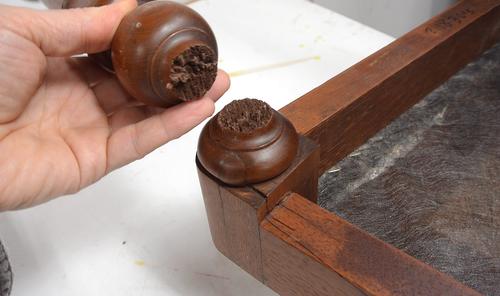
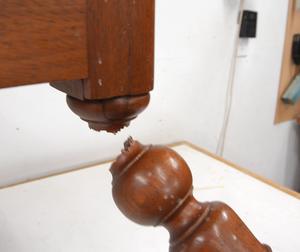 A friend had a family heirloom chair with a broken leg.
A friend had a family heirloom chair with a broken leg.

 A friend had a family heirloom chair with a broken leg.
A friend had a family heirloom chair with a broken leg.
The problem with this chair is that the legs are turned down too thin, creating a weak spot. Even if I fixed it good as new, it still wouldn't be very good. Initially I promised only to try gluing it back together, but then I had an idea for reinforcing it with a steel pin.
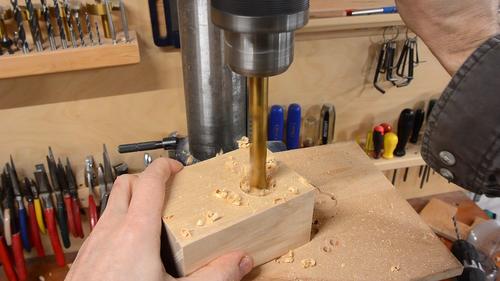
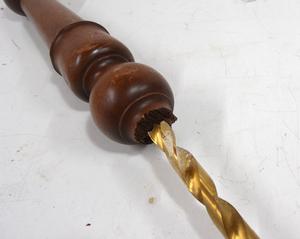 I needed to drill a hole exactly down the middle of both parts to get sufficient
alignment for a steel pin. I figured the best way to get this was to make
a jig out of wood. I first drilled a hole that would fit over the broken part,
then another hole in the middle to guide a the drill for drilling a hole
in the middle of the leg.
I needed to drill a hole exactly down the middle of both parts to get sufficient
alignment for a steel pin. I figured the best way to get this was to make
a jig out of wood. I first drilled a hole that would fit over the broken part,
then another hole in the middle to guide a the drill for drilling a hole
in the middle of the leg.
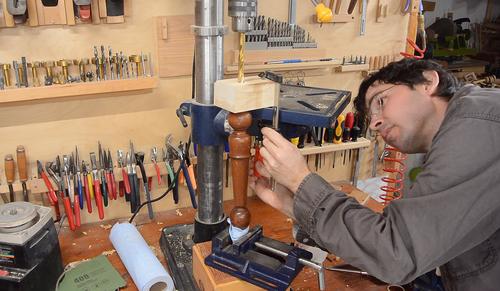
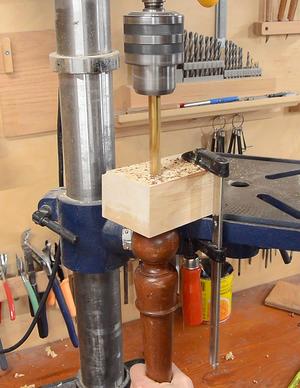 I mounted the leg in my drill press vise and clamped the block to the edge
of the drill press table
I mounted the leg in my drill press vise and clamped the block to the edge
of the drill press table
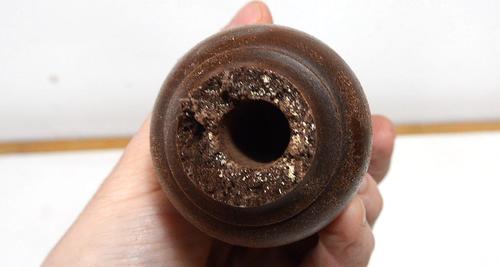 I wasn't careful enough setting things up. That hole was well off center.
Not good!
I wasn't careful enough setting things up. That hole was well off center.
Not good!
The only way I could save this now was to drill the hole with the same offset in the bottom of the chair seat. But I couldn't count on using my jig to line that up accurately enough.
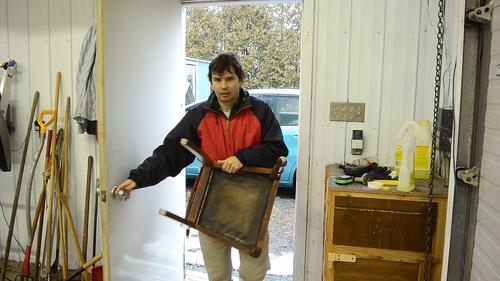 Time to head out to my big shop in the country
where I keep my horizontal boring machine.
Time to head out to my big shop in the country
where I keep my horizontal boring machine.
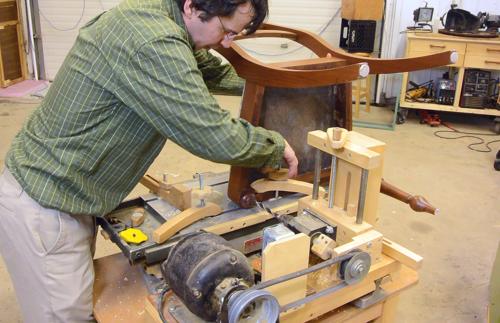 Clamping the chair body to the table of the horizontal boring machine.
Clamping the chair body to the table of the horizontal boring machine.
I don't use the horizontal boring machine very much. In part because setting stuff up on it takes longer than using a drill press, but also because it's a type of machine few people have. I can't encourage you to build one because this one relies on parts that I have no idea where they could be bought. It uses an old X-Y mill/drill table and a bearing block/drill chuck assembly. The table came from a surplus sale, the bearing block was given to me.
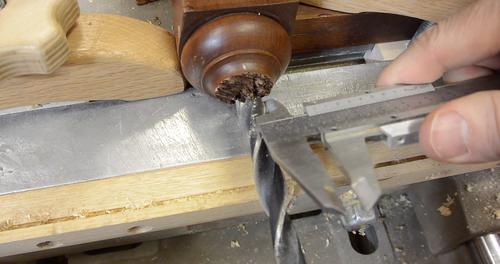
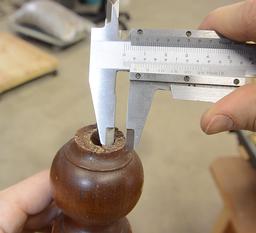 Then checking the offset of the hole in the leg and lining up the drill
to have the same offset in the chair part.
Then checking the offset of the hole in the leg and lining up the drill
to have the same offset in the chair part.
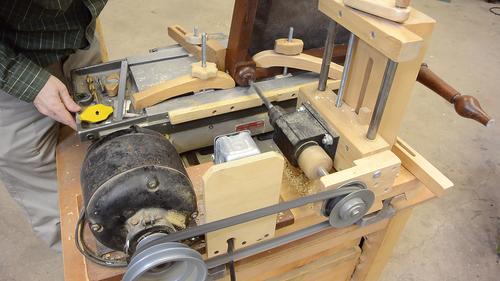
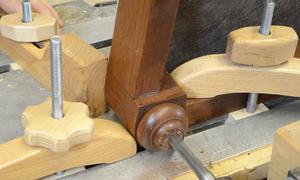 Chair clamped firmly on three sides. I started the hole, then stopped,
measured to make sure it was in the right spot, and then continued drilling.
Chair clamped firmly on three sides. I started the hole, then stopped,
measured to make sure it was in the right spot, and then continued drilling.

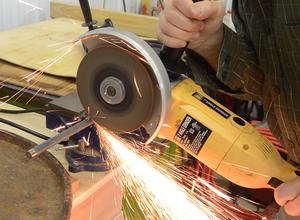 I cut the right length from a 12 mm shaft, that came from
this printer. It was the feed roller, with a rough texture to engage the
paper, so I couldn't use it for building machines anyway.
I cut the right length from a 12 mm shaft, that came from
this printer. It was the feed roller, with a rough texture to engage the
paper, so I couldn't use it for building machines anyway.
I couldn't get the leg on with the pin as well as I could without it. On careful examination, I realized the hole alignment may have been off by a fraction of a millimeter.
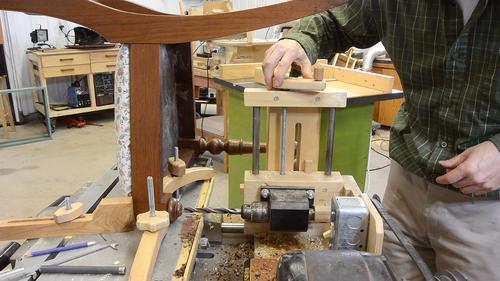 So I clamped the chair back on the machine, adjusted the drill position,
then slowly drilled again. There was some flexing of the drill bit
so I had to overcompensate for the offset, but I managed to get the hole
expanded enough get it into alignment.
So I clamped the chair back on the machine, adjusted the drill position,
then slowly drilled again. There was some flexing of the drill bit
so I had to overcompensate for the offset, but I managed to get the hole
expanded enough get it into alignment.
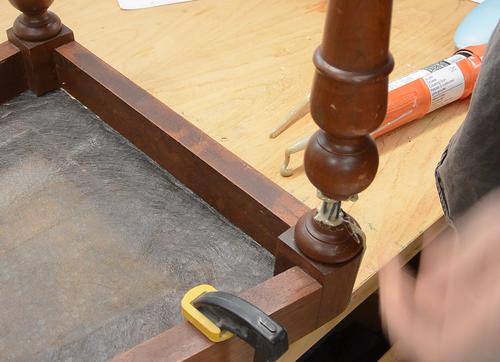 Back in my basement shop, I glued it back together. I used some PL premium
construction adhesive. It says it bonds metal, and it's a good gap filler
(the rod didn't fit as tight as a dowel), so I figured it was a good glue for
the job.
Back in my basement shop, I glued it back together. I used some PL premium
construction adhesive. It says it bonds metal, and it's a good gap filler
(the rod didn't fit as tight as a dowel), so I figured it was a good glue for
the job.
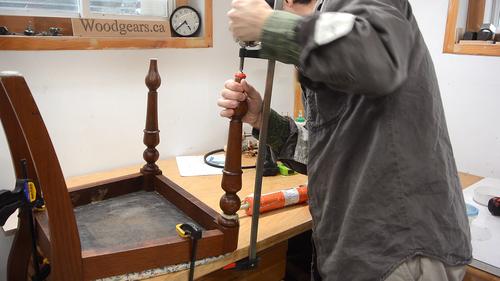
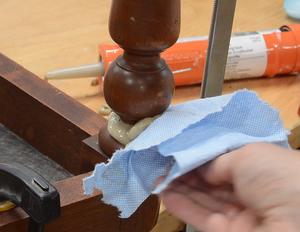 I made sure I had enough glue smeared on to fill the gap, but it turned out
to be too much glue. The pin acted like a piston, preventing me from getting
the leg all the way on. But slowly forcing it down with a clamp allowed the
glue to squeeze past the pin. I guess this, and the alignment, would have been
much easier if I had drilled the holes half a millimeter larger.
I made sure I had enough glue smeared on to fill the gap, but it turned out
to be too much glue. The pin acted like a piston, preventing me from getting
the leg all the way on. But slowly forcing it down with a clamp allowed the
glue to squeeze past the pin. I guess this, and the alignment, would have been
much easier if I had drilled the holes half a millimeter larger.
Fortunately, the glue cleaned up well with a rag.
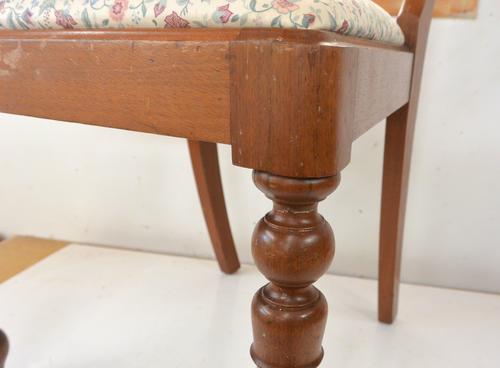 If you look closely at the leg, you can clearly see where it's joined, and it
may be half a millimeter longer than it was before. But with the steel pin,
that leg should definitely be stronger than it was originally.
If you look closely at the leg, you can clearly see where it's joined, and it
may be half a millimeter longer than it was before. But with the steel pin,
that leg should definitely be stronger than it was originally.
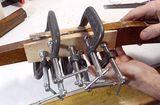 Scarf joint splice chair repair
Scarf joint splice chair repair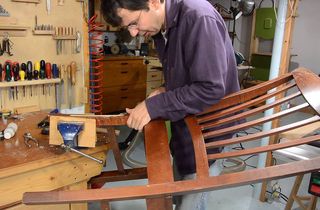 Another chair leg repair
Another chair leg repair Building kitchen chairs
Building kitchen chairs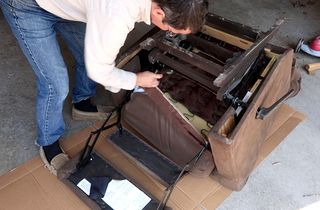 Fixing a reclining chair frame (video)
Fixing a reclining chair frame (video)